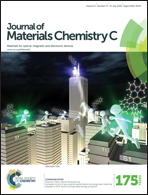Solvent-triggered relaxative spin state switching of [Fe(HB(pz)3)2] in a closed nano-confinement of NH2-MIL-101(Al)†
Abstract
The synthesis of the NH2-MIL-101(Al) Metal–Organic Framework (MOF) with bis(hydrotris(pyrazolyl)borato)iron(II), [Fe(HB(pz)3)2], added to the reaction medium yielded [Fe(HB(pz)3)2]@NH2-MIL101(Al) encapsulation products, denoted as S@Ms, in the course of a ‘bottle-around-the-ship’ assembly. [Fe(HB(pz)3)2] is a spin-crossover (SCO) compound with a gradual spin transition at 290–440 K for the bulk material (repeated cycles), associated with a pronounced colour change from the red low spin (LS) state to the white high-spin (HS) state. The identity of S@Ms, with a maximum loading of the iron complex at ∼11 wt% (0.16 molecules per Al3OL3 moiety), was confirmed by PXRD and spectroscopic measurements. The entrapped complex, which is stable in air and cannot be removed by vacuum drying, is confined in the cages of the framework. N2 and CO2 gas adsorption measurements on the dry S@M composite with different iron complex loadings confirm the absence of most of the initial NH2-MIL-101(Al) porosity. The S@M composite material demonstrates a gradual thermally induced transition from the red low-spin (LS) state to the light yellow HS state, associated with the colour of the matrix, chiefly over the range 300–450 K, which is close to the 290–440 K temperature range for [Fe(HB(pz)3)2]. The thermally induced HS form of S@M does not return to the LS upon cooling to room temperature, and the metastable HS form relaxes only very slowly, which becomes noticeable only after weeks of storage. Rapid and almost complete relaxation and decrease of magnetic moment for up to ∼97% of the whole sweep could be triggered by the addition of n-hexane, as evidenced by the change of colour and magnetic measurements. Via mechanical stress akin to the action of capillary forces, the adsorbed liquid effectively amplifies the otherwise very weak ‘matrix effect’ by increasing the effective local pressure imposed on the transiting molecules, thus favouring even further the LS state. The immersion of the dried composites into practically any typical solvents, including MeOH, DMSO, DMF, iPrOH, BuOH, t-BuOH, THF, ethylacetate, CH2Cl2, CHCl3 CCl4, toluene, mesitylene, and cyclohexane, also induces a spin state change, which is evidenced by the change of colour. The effect is fully reversible: the metastable HS state could be reinstated upon drying the sample at elevated temperature and subsequent cooling. The materials were thoroughly characterized by AAS, PXRD, gas sorption analysis, IR spectroscopy, magnetic measurements, and optical reflectivity measurements. Therefore, a novel MOF-based material with isolated SCO units is proposed, which demonstrates a salient relaxative ‘solvent assisted matrix-effect’ on metastable entrapped sites, potentially suitable for light-driven single-unit addressability.
![Graphical abstract: Solvent-triggered relaxative spin state switching of [Fe(HB(pz)3)2] in a closed nano-confinement of NH2-MIL-101(Al)](/en/Image/Get?imageInfo.ImageType=GA&imageInfo.ImageIdentifier.ManuscriptID=C6TC01297C&imageInfo.ImageIdentifier.Year=2016)

 Please wait while we load your content...
Please wait while we load your content...